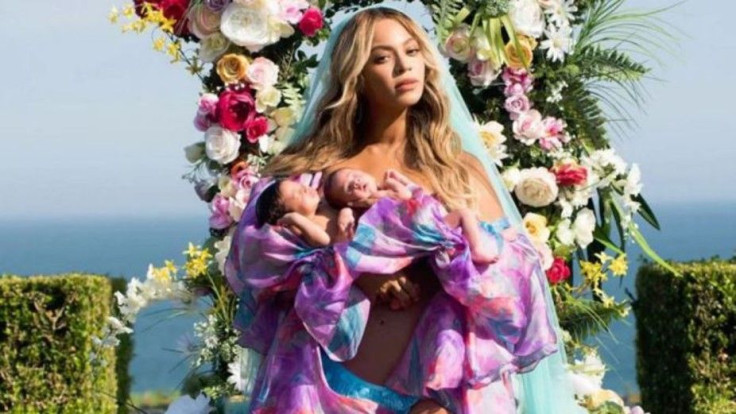The Symbolism Of Beyoncé's First Official Photo Of Her Twins

As befitting pop “royalty”, the singer Beyoncé Knowles has publicly released the first official photo of her twins – one-month-old Rumi and Sir Carter. The image – which quickly became one of the most liked on Instagram – echoed her pregnancy announcement from February, once again referencing religious and classical icons - this time Botticelli’s Venus. And, in a step that’s becoming something of a signature move for her, the Virgin Mary.
Throughout her pregnancy, Marian imagery has been central to Beyoncé’s self-representation. On the first day of Black History Month, she announced her pregnancy in an Instagram post that conflated goddess imagery and Virgin Mary symbolism and just a few days later delivered a show-stopping Grammy performance that drew from various religious iconographies, including Oshun, the Virgin Mary and Kali.
Beyoncé’s birth announcement, then, is an extension on the divine feminine theme. By referencing religious iconography, and particularly Virgin Mary symbolism, Beyoncé simultaneously reinforces and subverts dominant cultural narratives of motherhood.
Her representations of pregnancy draw from the Black Madonna tradition in which Mary – and sometimes Jesus – are represented in paintings and statues with dark skin. This tradition is associated with power, miracles and ancient mother goddesses. But it has also been subjected to whitewashing and used as a tool to perpetuate racism.
Catholic authorities have attempted to downplay or even erase the racial element of the Black Madonna by insisting that the darkness of these statues is caused by oxidization or discoloration from incense or candle smoke.
The famous Black Madonna at Chartres Cathedral, for example, was the subject of controversy in 2014 after it was repainted as part of a refurbishment – turning the Black Madonna white in the process. In a scalding article for the New York Review of Books, American architecture critic Martin Filler lamented:
Whenever and however Chartres’s Black Madonna acquired its mysterious patina—through oxidation or smoke from candles and incense – it was familiar as such to centuries of the faithful until its recent multicolored makeover, which has transformed the Mother of God into a simpering kewpie doll.
Black feminist writer bell hooks critiques the European worship of Black Madonna in her account of her post-college travels. She found Europe to be rampant with racism, despite Black Madonna veneration – and the worship of a black woman did nothing to “alter the politics of domination outside, in that space of the real”.
A (Black) woman’s place
Beyoncé, then, draws on a complex tradition of political resistance to disrupt white supremacist narratives of black motherhood. Her representations haven’t gone without criticism, however.
Beyoncé’s pregnancy and birth images have been critiqued for glorifying, glamorizing and romanticizing motherhood. Sharon Kellaway, an Irish woman who also just gave birth to twins, parodied Beyoncé’s Instagram birth announcement to show ordinary women’s experience of motherhood, saying that the singer looked “so unrealistic”.
Certainly, Beyoncé’s perfectly honed post-pregancy body isn’t common to most new mothers. Celebrity pregnancies are hyper-commodified and the shot of the celebrity post-partum figure is a far more desirable than a photo of the baby. Beyoncé has controlled the representation of her body by managing and releasing her own image. But the capability of a celebrity with extreme wealth, a management team, personal trainers and stylists, chefs and round-the-clock childcare, to make a speedy return to socially accepted standards of beauty is used to control “ordinary” women.
Film and media academic, Rebecca Feasey, observes that “irrespective of the reality of celebrity pregnancy, delivery or the ensuing maternal role, what is represented is an orchestrated and deliberately considered image of motherhood”. The tabloids and gossip magazines have been quick to congratulate Beyoncé on her almost immediate return to shape – thereby presenting her as an example of appropriate post-pregnancy body discipline to women readers and linking women’s maternal bodies to “good” or “bad” motherhood. As sociologist Meredith Nash argues “a fit, risk-free, flexible, and responsible body is the mark of a good mother”.
Beyoncé’s images have also been criticised for reinforcing an pro-natalist narrative which insists that women’s value lies in motherhood. Beyoncé’s “endless Virgin Mary/Sun goddess routine” at the Grammys exercised New York Post journalist Naomi Schaeffer Riley, who responded:
Why is it that in an era when women are constantly insisting that they should not be defined by their traditional, biological roles, we have fetishised motherhood to such an extent? … Our cultural imperative to elevate motherhood to both the most important thing in the world and the hardest thing in the world is getting out of control.
Disrupting stereotypes
Schaeffer Riley was promptly rebutted by Australia-based Tongan writer Meleika Gesa-Fatafehi: “The article is written by a white woman who shames motherhood, especially black motherhood.”
Gesa-Fatafehi makes a powerful point. The criticisms of Beyoncé’s Virgin Mary imagery fail to address the racial politics of motherhood and the overtly political statement Beyoncé makes in her use of religious iconography. She draws from the most culturally influential imagery to disrupt dominant stereotypes of black motherhood.
As the American feminist writer Amber E. Kinser wrote:
Women of colour … have historically been more concerned with having the children they choose, rather than being forced to produce children through slavery or rape or forced to stop producing children through sterilization; keeping their children, rather than seeing them sent off to assimilation boarding schools, sold off as slaves, or taken from them because nonwhite mothering practices are distrusted; and raising their children in ways they’ve determined are best for their families, rather than having their cultural values, histories, and ways of speaking denigrated in schools, public policy, and other institutions such as healthcare and media.
In her pregnancy and birth images, Beyoncé effectively negotiates a terrain most closely associated with whiteness – “good” motherhood. Good for her and good for all of us.
Katie Edwards, Director SIIBS, University of Sheffield
This article was originally published on The Conversation. Read the original article.






















